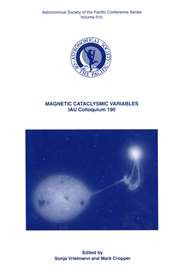Article contents
Variable Stars in the MACHO Collaboration1 Database
Published online by Cambridge University Press: 12 April 2016
Abstract
The MACHO Collaboration’s search for baryonic dark matter via its gravitational microlensing signature has generated a massive database of time ordered photometry of millions of stars in the LMC and the bulge of the Milky Way. The search’s experimental design and capabilities are reviewed and the dark matter results are briefly noted. Preliminary analysis of the ~ 39,000 variable stars discovered in the LMC database is presented and examples of periodic variables are shown. A class of a periodically variable Be star is described which is the closest background to microlensing which has been found. Plans for future work on variable stars using the MACHO data are described.
- Type
- Part 1. The Scientific Programme
- Information
- International Astronomical Union Colloquium , Volume 155: Astrophysical Applications of Stellar Pulsation , 1995 , pp. 221 - 231
- Copyright
- Copyright © Astronomical Society of the Pacific 1995
Footnotes
Center for Particle Astrophysics, University of California
The MACHO Collaboration is a collaboration between the Lawrence Livermore National Laboratory (DOE), Mount Stromlo and Siding Spring Observatories (ANU), and the Center for Particle Astrophysics at the University of California, Berkeley (NSF).
References
- 7
- Cited by




